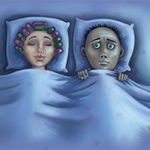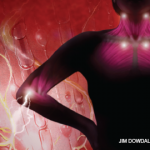Treatment Obstacles
Some insurance companies ignore this evidence-based approach and promote or even insist on the use of lorazepam, Silenor, trazodone and Rozerem. Please note that the inconsistent (alternative trade and generic) naming is that used and promoted by the insurance company. Those medication alternatives appear as illogical as the above linguistic inconsistencies:
Fifty percent of individuals treated with a hypnotic had not just slight improvement, but resolution of fibromyalgia.
Antidepressants are illogical for treatment of sleep disorders, because they directly suppress REM sleep.37,41 Lorazepam is not even approved by the FDA for sleep. It is an antianxiety agent, a sedative—not a sleep-restoration agent. It dulls mentation and certainly does not restore Stage IV sleep.42 It decreases REM sleep and even eliminates Stage IV sleep.43-45 It actually impairs next-day functioning, the opposite of the effect desired in individuals with fibromyalgia.46
Silenor (doxepin) is a tricyclic antidepressant promoted for difficulty maintaining sleep, not for ensuring Stage IV depth of sleep.20 It had no effect on Stage IV sleep, and its use was discontinued in 10% of patients entered into a study of its use for primary insomnia because of increased liver enzymes, leukopenia and thrombocytopenia.20,47 It is contraindicated in the presence of sleep apnea, depression, diabetes and those receiving the ever-present (at least in patients afflicted with musculoskeletal disorders or GERD) gastroprotective agents.
Trazodone shares those caveats and is additionally contraindicated in individuals with heart disease or seizure disorders. Indeed, trazodone was found not to exceed placebo effect on sleep.38 It is actually indicated for depression, not as a sleep aid—despite its wide prescription for the latter.48 Sedation, dizziness and psychomotor impairments are major high-frequency side effects.49 Trazadone does not augment Stage IV or REM sleep.50 Mendelson noted the dearth of efficacy data, suggesting an unacceptable risk–benefit ratio with its use.49
Rozeron (ramelteon) has “no clinically meaningful effect on sleep architecture” or any subjective sleep measure.51,52 It actually decreases the percentage of time in Stage IV sleep.53
If we ignore the depressive effect of chronic pain, it still should be noted that depression is a contraindication to the medications promoted by insurance companies. Not only are the promoted drugs dangerous by themselves, but they complicate patient care and place patients at greater and unnecessary risk.
To Think About …
Should insurance company “protocols” not be held to the same standards as the peer-reviewed literature? What are the qualifications of those doctors and pharmacists who insurance companies allege as having established these protocols, the “lists of acceptable medications,” and why do insurance companies appear so reticent to identify these “experts”? It seems obvious that there needs to at least be a dialogue, but how does one effectively communicate with insurance companies that don’t even have the courtesy to respond?


